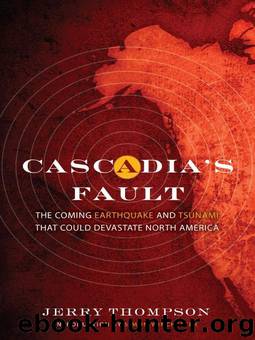Cascadia's Fault by Jerry Thompson; Simon Winchester

Author:Jerry Thompson; Simon Winchester
Language: eng
Format: mobi
Tags: Non-fiction
ISBN: 9781582436432
Publisher: Counterpoint
Published: 2011-05-01T00:00:00+00:00
Gary Carver’s memory of that deceptively sunny day was just as vivid. The shockwaves hit while he was driving to his office on the Humboldt State campus in Arcata. After the ground stopped moving he quickly rang home to make sure everything was okay there, then rounded up a bunch of graduate students and headed straight for Petrolia. By about noon the USGS had told them where to find the epicenter. They began scouring the countryside looking at landslides and other physical damage—without ever finding a surface fault.
Because the ocean was high and rough that day Carver and company failed at first to see the quake’s most geologically significant wreckage. Several days after the jolt, however, the HSU crew stopped for lunch in a Petrolia café, where they overheard local residents in the next booth talking about how much the shoreline had changed. Offshore rocks normally submerged were now high and dry and the place “smelled like fish stew.”
So Carver and his colleagues headed back toward the beach and sure enough a big swath of California landscape had been hoisted up sharply into new marine terraces. For the next several days the HSU team hiked the shoreline, documented the vertical displacement, and watched while acres and acres of shellfish clinging to rocks that once lay beneath the sea died and rotted.
The seismic data showed an almost flat focal plane and the nearly horizontal motion of a thrust fault, agreeing with what Carver could plainly see on the beach—the upper plate had popped loose from the subducting ocean floor and ridden up over it. “It produced coseismic uplift,” he noted, “just like the ’64 one did. Except it was all in miniature.” In essence the continental plate along California’s western shore got massively and permanently deformed during the rupture, the same thing George Plafker had seen in both Alaska and Chile.
“When you analyze exactly where that hypocenter or focus of where the earthquake was, it really coincides very closely with where we think that subduction zone interface is,” said Dengler, equivocating only slightly. “I mean there’s still some debate amongst the scientists as to whether it was really the main subduction zone or a subsidiary fault. And there’s also some debate as to really where the end of the subduction zone is and how complicated things get down there in that Triple Junction region. But I think we all agree that it was a thrust fault and it was clearly related to the subduction zone. And so it became really the first major earthquake to occur on the subduction zone or a very closely related fault.”
“The Petrolia earthquake was a subduction zone earthquake because it broke on the subduction zone,” said Carver, equivocating not at all. “The boundary between the Gorda plate and the North America plate is a very low-angle thrust fault. And it slipped and caused this uplift and subsidence of the coast and generated this earthquake,” he said. “It was a subduction zone earthquake, as far as I’m concerned.
Download
This site does not store any files on its server. We only index and link to content provided by other sites. Please contact the content providers to delete copyright contents if any and email us, we'll remove relevant links or contents immediately.
The Lonely City by Olivia Laing(4121)
Animal Frequency by Melissa Alvarez(3755)
All Creatures Great and Small by James Herriot(3517)
Walking by Henry David Thoreau(3235)
Exit West by Mohsin Hamid(3184)
Origin Story: A Big History of Everything by David Christian(3139)
COSMOS by Carl Sagan(2950)
How to Read Water: Clues and Patterns from Puddles to the Sea (Natural Navigation) by Tristan Gooley(2855)
Hedgerow by John Wright(2777)
The Inner Life of Animals by Peter Wohlleben(2767)
Origin Story by David Christian(2684)
How to Read Nature by Tristan Gooley(2666)
Project Animal Farm: An Accidental Journey into the Secret World of Farming and the Truth About Our Food by Sonia Faruqi(2661)
How to Do Nothing by Jenny Odell(2645)
A Forest Journey by John Perlin(2588)
Water by Ian Miller(2584)
The Plant Messiah by Carlos Magdalena(2454)
A Wilder Time by William E. Glassley(2364)
Forests: A Very Short Introduction by Jaboury Ghazoul(2335)
